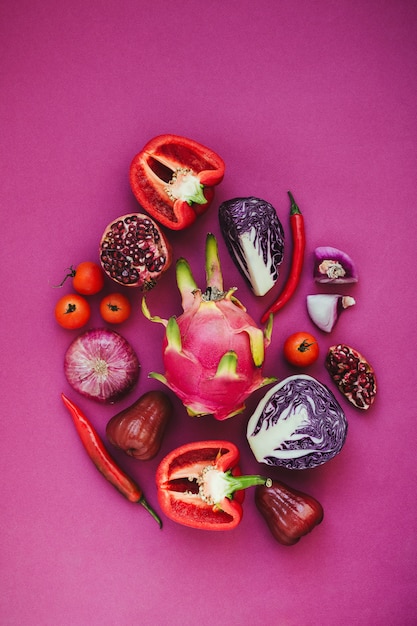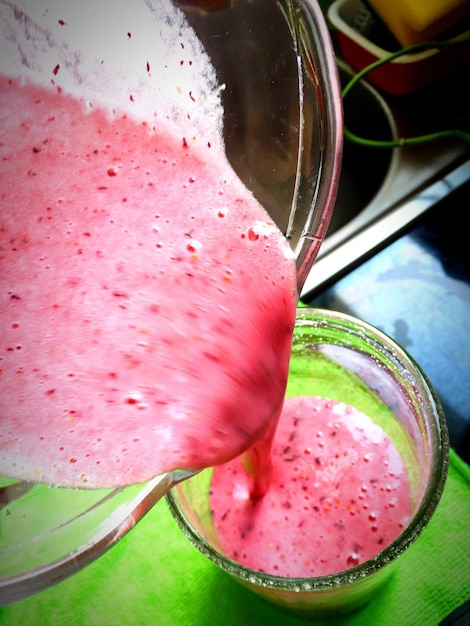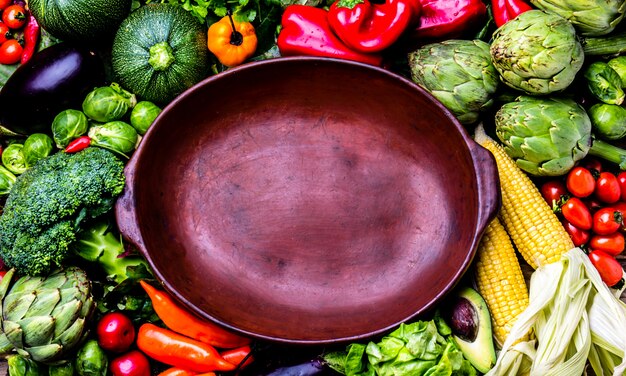How to Eat More Fruits and Veggies: 10 Simple Tips for Your Diet

How to Incorporate More Fruits and Vegetables into Your Diet: 10 Easy Tips involves simple strategies like adding fruit to breakfast, snacking on veggies, and creatively incorporating them into meals for a healthier lifestyle.
Want to boost your health and energy levels? Learning how to incorporate more fruits and vegetables into your diet: 10 easy tips can transform your eating habits and overall well-being. Let’s explore some simple and delicious ways to increase your intake of these essential foods!
Easy Swaps and Additions
Making small changes to your existing meals is a fantastic way to sneak in extra servings. It’s all about finding opportunities to boost the nutritional value of what you already enjoy.
Add Fruit to Your Breakfast
Start your day with a burst of flavor and essential nutrients. Adding fruit to your breakfast is a simple yet powerful habit.
- Top Your Cereal: Sprinkle berries, sliced bananas, or peaches on your morning cereal for added sweetness and vitamins.
- Blend a Smoothie: Throw some spinach, a banana, and your favorite fruits into a blender for a quick and nutritious smoothie.
- Mix into Oatmeal: Stir in chopped apples, pears, or a handful of raisins into your oatmeal for a warm and satisfying breakfast.
By incorporating fruit into your breakfast, you’re setting a positive tone for the rest of the day.

Sneak Veggies into Familiar Dishes
Integrating vegetables into your favorite dishes doesn’t have to be a chore. It’s about being inventive and utilizing familiar flavors.
- Add Spinach to Pasta Sauce: Blend spinach into your tomato sauce to boost its nutritional content without altering the taste significantly.
- Mix Cauliflower into Mashed Potatoes: Steam and mash cauliflower into your mashed potatoes for a lighter, healthier version.
- Grate Zucchini into Baked Goods: Incorporate grated zucchini into muffins, bread, or cakes; it adds moisture and nutrients without being noticeable.
These small tweaks can increase your vegetable intake without sacrificing taste or enjoyment.
These initial changes create a foundation for more significant dietary improvements, making the transition to a healthier lifestyle manageable and enjoyable.
Creative Snacking Strategies
Snacking offers prime opportunities to increase your fruit and vegetable intake. With a little planning, you can turn snack time into a nutritional boost.
Keep Cut Veggies Handy
Having pre-cut vegetables readily available makes snacking on them a no-brainer. Preparation is key to making healthy choices convenient.
- Store in the Fridge: Keep a container of carrot sticks, cucumber slices, and bell pepper strips in the refrigerator for easy access.
- Pair with Dips: Combine your cut veggies with hummus, guacamole, or yogurt-based dips for added flavor and nutrition.
- Pack for On-the-Go: Prepare small bags of cut vegetables for taking to work, school, or while running errands.
When hunger strikes, these ready-to-eat options can help you avoid less healthy choices.
Opt for Fruit Over Processed Snacks
Swap out processed snacks for fresh fruit to satisfy your sweet tooth while nourishing your body.
- Choose Seasonal Fruits: Enjoy fruits that are in season for optimal flavor and nutrient content.
- Keep a Fruit Bowl Visible: Place a bowl of apples, oranges, and bananas on your counter to remind you to choose fruit.
- Combine with Nuts or Seeds: Pair your fruit with a handful of nuts or seeds for a satisfying and balanced snack.
By making these simple swaps, you can transform your snacking habits and reap the benefits of increased fruit and vegetable consumption.
Snacking smart is a game-changer for improving your diet. These strategies can make a significant impact on your overall health.
Meal Planning and Prep
Effective meal planning and preparation are crucial for maintaining a diet rich in fruits and vegetables. When you plan ahead, healthy choices become much easier to make.
Plan Your Meals in Advance
Taking some time each week to plan your meals can help you prioritize fruits and vegetables.
List out each meal for the week, including breakfast, lunch, dinner, and snacks. Then, brainstorm how you can incorporate fruits and vegetables into each meal. Preparing a detailed list will ensure a balanced grocery list, and reduce the chances of opting for takeout options.
Wash and Chop Produce Immediately
As soon as you bring your groceries home, take the time to wash and chop your fruits and vegetables. This simple step makes them more accessible and appealing for snacking or cooking.
- Store in Clear Containers: Place your washed and chopped produce in clear containers in the refrigerator. This visual reminder will encourage you to use them.
- Prepare Salad Ingredients: Wash and chop lettuce, tomatoes, cucumbers, and other salad ingredients ahead of time. This makes it easy to throw together a salad for lunch or dinner.
- Portion into Snack Bags: Divide your chopped fruits and vegetables into individual snack bags for easy grab-and-go options.
Cook Once, Eat Multiple Times
Maximize your time by cooking large batches of vegetable-rich dishes that you can enjoy throughout the week. Casseroles, soups, and roasted vegetables reheat easily and provide multiple servings.

With proper preparation and planning, incorporating fruits and vegetables into your diet is effortless.
Grow Your Own
Starting a garden, even a small one, can be a great way to ensure you have fresh fruits and vegetables available. Gardening can be a fun and rewarding way to incorporate more produce into your life, providing a steady supply of fresh, homegrown goods.
Start Small with Herbs
If you’re new to gardening, herbs are an excellent place to start. They’re easy to grow and can add a lot of flavor to your meals.
Plant basil, mint, cilantro, and parsley in pots on your windowsill or balcony. Use them to season salads, soups, and other dishes for a burst of fresh flavor and added nutrients.
Grow Salad Greens in Containers
Salad greens are another easy option for beginner gardeners. Plant lettuce, spinach, and arugula in containers on your patio or balcony.
- Harvest Frequently: Harvest the outer leaves as needed, allowing the plants to continue producing throughout the season.
- Succession Planting: Plant new seeds every few weeks to ensure a continuous supply of fresh greens.
Consider a Community Garden
If you don’t have space for a garden at home, consider joining a community garden. This is a great way to meet new people, learn gardening skills, and grow your own fruits and vegetables.
Growing your own produce will increase your appreciation for fruits and vegetables and help ensure you have a steady supply of healthy options.
Explore New Recipes
Venturing into new recipes can be a fun way to discover new fruits and vegetables, and new ways to prepare classic produce.
Try a New Vegetable Each Week
Challenge yourself to try a new vegetable each week. Visit your local farmers market or grocery store and pick out a vegetable that you’ve never tried before.
Research different ways to prepare it and incorporate it into your meals. You might discover a new favorite vegetable that you never knew existed!
Experiment with Fruit-Based Desserts
Fruit can be a delicious and healthy alternative to processed desserts. Experiment with fruit-based desserts like baked apples, fruit crisps, and smoothies.
- Bake Apples with Cinnamon: Core apples, fill with cinnamon and a touch of honey, and bake until soft for a warm and comforting dessert.
- Make Fruit Crisps: Combine sliced fruit with a topping of oats, nuts, and spices, and bake until golden brown.
- Blend Fruit Smoothies: Blend frozen fruit with yogurt or milk for a quick and refreshing dessert.
Find Inspiration Online
The internet is full of recipes and ideas for incorporating more fruits and vegetables into your diet. Explore food blogs, websites, and social media channels for inspiration.
Experimenting with new recipes and flavors will keep your diet interesting and ensure you’re getting a wide variety of nutrients.
Make it a Habit
Consistency is key when it comes to incorporating more fruits and vegetables into your diet. Making it a habit is the best way to ensure long-term success.
Set Realistic Goals
Don’t try to make too many changes at once. Start with small, achievable goals and gradually increase your intake over time. For example, aim to eat one serving of fruit or vegetables with each meal.
Track Your Progress
Keep a food diary or use a tracking app to monitor your fruit and vegetable intake. This will help you stay accountable and identify areas where you can improve. Reward yourself for reaching your goals with non-food treats.
By setting smart goals, tracking your habits, and surrounding yourself with a supportive network, you increase you chances of creating new healthy habits that last a lifetime.
| Key Point | Brief Description |
|---|---|
| 🍎 Add Fruit to Breakfast | Start your day with fruits in cereal, smoothies, or oatmeal. |
| 🥕 Keep Cut Veggies Handy | Prepare carrot \u000bcucumber sticks for quick, healthy snacking. |
| 🌱 Grow Your Own Herbs | Plant easy-to-grow herbs to season your meals with fresh flavors. |
| 🥗 Plan Your Meals | Incorporate fruits and vegetables into meal planning. |
Frequently Asked Questions
▼
Fruits and vegetables are packed with vitamins, minerals, and antioxidants, which support overall health, boost immunity, and protect against chronic diseases like heart disease and cancer.
▼
Aim for at least five servings of fruits and vegetables per day. This recommendation can vary based on individual needs and dietary guidelines, but it’s a good general target.
▼
Puree vegetables into sauces, make veggie-packed smoothies, cut veggies into fun shapes, or let kids help with meal prep to increase their interest and acceptance.
▼
Yes, frozen fruits and vegetables are often just as nutritious as fresh because they are typically frozen shortly after harvest, preserving their vitamins and minerals.
▼
Buy seasonal produce, shop at farmers’ markets, plan your meals ahead of time, and consider growing your own vegetables to save money while eating healthily.
Conclusion
Incorporating more fruits and vegetables into your diet doesn’t have to be a daunting task. By implementing these simple tips and tricks, you can gradually transform your eating habits and enjoy the numerous health benefits that come with a diet rich in these vital foods. Start with small changes and build from there, and you’ll be well on your way to a healthier, happier you!
